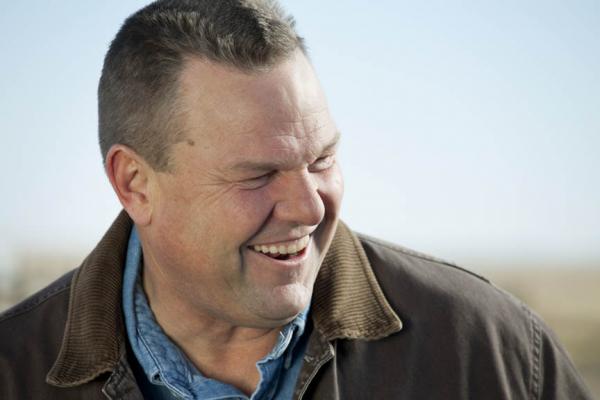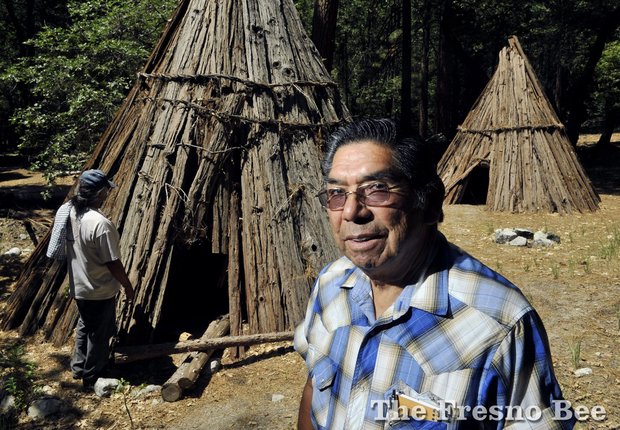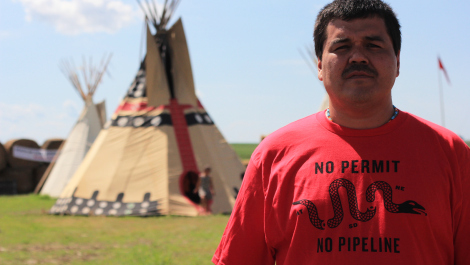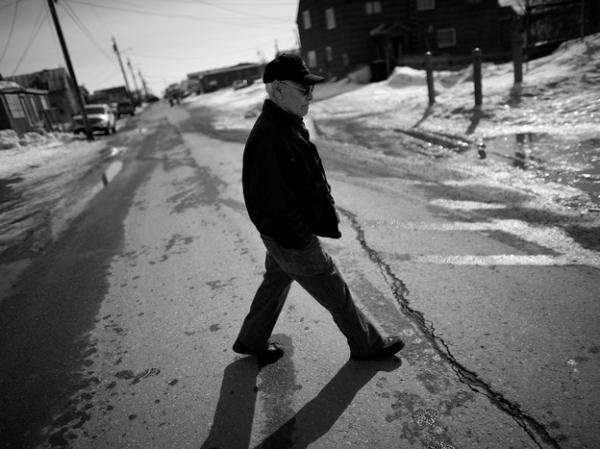In comparison to predecessors who have led the Senate Committee on Indian Affairs, Jon Tester (D-Montana) is a different creature. He’s not too prickly, nor harsh with staff; he’s not seen as overly idealistic, nor super controlled. And he doesn’t appear to have a passing interest in Indian issues, either; in other words, he’s not intent on leaving them behind when he finds a bigger fish to focus on.
While he’s been in the Senate since 2007, he’s still a farmer. Before that, he was a music teacher, and he has a Bachelor of Science in music, too. His wife: also a farmer. He’s visited the reservations in his state. He knows why the Indian vote matters, especially now as the Senate – part of a currently dysfunctional Congress, he laments – hangs in the balance.
Visiting him in the Hart Senate Office Building, it’s clear that he is a comfortable, candid, common-sense man who is focused on Indian stuff because he cares about it, and he wants to get it right. In person, he seems nicer, more jolly, than one gets a sense during committee hearings. He seems good, normal, real—a tribal ally who has a chance to show real power in this domain for years to come if he so chooses and if the voters in his conservative state continue to keep him in office.
He has been in the Senate for a rather short time to already be leading a committee. But it was his destiny after senior Montana Democratic Sen. Max Baucus retired to become an ambassador to China, and Sen. Maria Cantwell (D-Wash.) decided to move on at the beginning of this year to chair the Small Business Committee.
Cantwell has been criticized for not moving as much critical legislation as Indian country would have liked during her year holding the gavel, and Tester knows the score there. It’s one reason why he’s already passed 15 pieces of legislation through the committee on housing, education, water rights, and a sure-to-be complicated legislative fix to the 2009 Supreme Court Carcieri decision that limited the Department of the Interior’s ability to take lands into trust for tribes. With four hearings scheduled for July alone on some touchy subjects, including gaming and the Cobell settlement, at a time when many of his colleagues are prepping for summer break, perhaps his biggest challenge will be to not flood the engine.
RELATED: Under Tribal Scrutiny: Cantwell Exiting SCIA; Tester to Take Charge
On a late-June humid day in Washington, he wore a white dress shirt, top buttons unbuttoned, no tie, no suit coat. Famous crew cut front and center. Simple desk. No ornate decorations on the walls.
“Welcome,” he said, first looking at the reporter’s colorful tie, lamenting that he’s been instructed to wear toned down ties when he appears on television. “That’s a tie I’d like to wear on TV.”
And, with that, an interview began, touching on a range of pressing issues Tester says he wants to accomplish alongside his Indian allies—making clear that he can only be successful if Indians are willing to take responsibility and lead the way on improving their own prospects.
You have really started out of the gate running. How are you feeling at this point in your chairmanship?
I think we are in pretty good shape. We have pushed a lot of bills out of the committee. We really have taken some of the less controversial bills and moved down the line. I think our next challenge is taking the bills that we’ve gotten out of committee and the ones that don’t get taken up by unanimous consent, figuring out a strategy for the lame duck. Maybe an omnibus Indian bill going forward that could include a lot of stuff, including, potentially, a Carcieri fix. Secondly, particularly related to the hearings we’ve held on education, we need to write up an education bill, get it out of committee. The same thing may be true of economic development: get a bill that deals with economic development in Indian country, and get it out of committee.
Was Sen. Cantwell’s tenure last year – which some people criticized as moving too slow – necessary to get you to this point of action?
Maybe it was. I never thought about it that way. I think Maria did a great job as chairman of the committee. When she stepped aside and I took over the committee, knowing Mary [Pavel, staff director of the committee] for many years, I asked her to characterize the easy bills, the medium bills, and the tough ones. And we proceeded from there. Because we kept the same staff, it allowed Mary to have a solid scope of the landscape because she had worked a year with Maria on the committee.
How are you getting along with these staffers who you didn’t choose?
They’re all really good folks. I like them. They all bring different levels of expertise to the table; like to have fun; easy to be around. It’s a very good staff.
One thing that some in Indian country were worried about given the rapid exit of Sen. Cantwell was that it might take you another year to build your own machine.
Thankfully I have known Mary since I got here [to the Senate]. And I was confident that she would not put substandard people around here, and she hasn’t.
You mentioned an omnibus Indian bill that would hopefully tie in several Indian-focused legislative efforts. When would something like that happen, and are you talking about a standalone bill focused just on Indian issues?
Yeah, there are two ways to approach it. We could look for different bills to attach things on as amendments. Or we could put a standalone together. To be bluntly honest with you, I’ve got to talk to Harry [Reid, Senate Majority Leader (D-Nevada)]. I haven’t talked to him yet, because we haven’t talked as a staff yet on what we want to do. If Harry says no, we can’t do an omnibus bill, then we fall back to tell him that we want to attach them to bills to get votes on them…. We didn’t do all this work just for show. We are going to try to get something functionally done at the other end.
Do you worry if it’s a standalone bill that would present too many opportunities for other senators to want to get their compromises in there; whereas if it is attached to another bill, it might be less likely to be tinkered with?
There are some advantages and disadvantages going both ways, and you have touched on them. The advantage of a standalone Native American bill is that it has never been done before, and you have some great Native bills out there right now that have been carried by both Republicans and Democrats. So I think we could have a truly bi-partisan effort moving forward here. I think the big issue is going to be whether there is going to be enough time. Will Harry give me enough time to do a Native American bill?
Majority Leader Reid has been vocal on Indian issues lately, leading the way against the Redskins team name, introducing legislation to expand trust lands for Nevada tribes.
Yes, he was very supportive when I took the gavel, and he told me to get to work and do some stuff. So I can always remind him of that when I go to ask him about this bill.
You recently held a hearing on tribal economic development. Everyone talks about wanting to fix the economies of struggling reservations, but that kind of talk has happened throughout American history, really. How do you change that?
I tell you how to change it. We don’t fix it from Washington, D.C., and they don’t fix it on the ground. We have to work together. That’s one of the reasons why we have tried to be as transparent and as encompassing as we can be on this committee. We need Native Americans’ input. The programs that we set up and potentially fund, they have to be held responsible for doing the right thing to be sure their kids are getting an education, or the money is being spent right for economic development.
If tribes think that I can fix their economy, I can’t. The whole Congress can’t fix their economy. The truth is, with good communication, working together, we can fix it together. I’ve also got to find Indian leaders who are willing to step up. And I think we’ve found some who are willing to step up and say this is what we need to do in Indian country to make things work, and then we [Congress] need to support it.
The principle of self-determination has been around for a long time, and some tribes have been able to more successfully take advantage of the opportunities involved with it. Why have some tribes not been able to take advantage of those opportunities?
I don’t know. Sometimes the federal government holds them back. Some tribes have done it better than others. We had a hearing in Montana on Indian healthcare, and it was very apparent to me that the tribes that were block granted the money were doing a better job than the others. That’s about self-determination and them taking responsibility.
The tribes that are doing very well have now been able to become a part of the American political system, hiring strong lobbyists, making big campaign finance donations. What is your role in thinking about all that and how it juxtaposes against the needs of the most struggling tribes?
Every one of those tribes that are struggling has opportunity, and I think we have to figure out ways that they can expand on that opportunity. But it really has to be driven from the local level. You know, I can’t walk on to [the] Crow [reservation] and say, you know, you guys have great opportunities in tourism, and we need to do this, this, and this. That isn’t going to work. They need to come with the program and ask if there is any way for the federal government to help out.
You want tribes, especially ones that are struggling, to be bold in taking advantage of self-determination opportunities.
Yes, that’s right. Make no mistake: I know how difficult it is. When you’re poor, you’re poor. It’s hard to come up.
Is the Congress being bold enough in pushing new economic endeavors?
No, and part of it has to do with the economic constraints we have on us due to the debt, wars, and everything that has transpired over the last 15 years. There are limited opportunities now, but we need to take advantage of the limited opportunities that we have.
Does this situation change for the better while you are serving in Congress?
Well, I hope so. But this is a pretty dysfunctional place. I wish I could tell you this place is running like a Singer sewing machine, but it ain’t. It’s pretty tough. We can have the best ideas, and somebody will put a hold on them, and then that’s that. But that doesn’t mean you don’t keep trying. And, by the way, if you keep trying, I think that sets a really good example for the folks in Indian country.
Is the administration being bold enough on tribal economic development?
I think they’re pretty good, but they’ve got a ways to go yet, too. I think they’ve done some really good work, but they are under the same fiscal constraints that we are.
Would you support the president creating a Cabinet level Native affairs position?
I think, absolutely, it would be a great idea. Number one: they would have a better understanding of the challenges in Indian country than I would. Second: that voice out there talking about what needs to be done is important because it not only helps Indian folks, it helps everybody.
Jodi Gillette and other advisors in this administration focused on Indian issues are not Cabinet level.
I tell you, Jodi Gillette has as much influence right now as any Cabinet person. She’s got the president’s ear. I think, regardless of what the position is called, you have to have someone that the president trusts and will listen to.
Would you like to see the president create a tribal economic development council composed of Indian leaders?
I think it’s a good idea. If in fact this is something that can happen, we will talk about it as a committee, and send a letter off.
You’ve said your clean Carcieri legislative fix that would help reservation economies still faces a lot of hurdles.
Yes, and it’s no different now than ever before.
What does that mean?
That means that we’ve got to find 60 votes, and there are people out there on the Democratic side who don’t like it, and I’m sure there are people on the Republican side who don’t as well. This is truly going to have to be a bipartisan effort, or it isn’t going to work to get a clean fix. Our challenge is going to be finding those 60 votes. I think a clean fix is the way to go, but I am not stupid about the legislative process. We need to get it through. I don’t think that two classes of Native Americans is a good idea. So we’ve got to find the 60 votes. We’ve got to do some serious talking with Sens. [Dianne] Feinstein, Jack Reed, [Chris] Murphy, [Richard] Blumenthal – these are all friends of mine – to let them know that I do not see the boogeyman out there in this bill that they do. We’ll see how effective I am in that.
Three SCIA chairmen before you have said the same thing about trying to build a coalition—
It’s never happened.
What makes you the one?
I’m a better guy. [laughs] No, I don’t know. A lot of it is timing; a lot of it is luck, too. Just as everything else, you push forward, and maybe the key will fit the lock.
So you’re working your Democratic friends?
We haven’t started yet. We’ve passed it out of committee. I have not had the hard conversation with Dianne [Feinstein] or any of the other four.
What is the hard conversation?
The hard conversation is to sit down with them and say I want to make this real. We need to figure out a way to allay their fears. If we’re successful in doing that, fine. If it comes to a point that we can’t be successful, then it becomes a little more difficult. Feelings get hurt and all that stuff. But I think that we’re all grownups here, and I think this issue has been around long enough that we should be able to get to the root problems and get them resolved.
Your vice-chair, Sen. John Barrasso (R-Wyoming), how important is he in all this?
He is very important. He and [Sen. Jerry] Moran [R-Kansas] are the two keys to this puzzle. Moran because he is a co-sponsor. And if Barrasso were to come out hard against it, it would make this thing very difficult to pass.
In your ideal world, would he be working arm and arm with you on this?
In my ideal world, he would be.
And he’s not?
Well, we haven’t had that conversation yet, either. I don’t know where he’s at. I know where Jerry is. And Jerry is willing to go to the mat for us. Hopefully he will go to the mat with Barrasso. At the very least, Barrasso has to be neutral. If he’s opposed to it, we’ve got a problem. We don’t absolutely need him, but it would make life easier if we have him.
In committee, Sen. Barrasso recently proposed an amendment to study Carcieri and its effects on tribes, and it passed. More study?
Yeah, that’s something we do here all the time. We study stuff all the time, and then we study it some more. I think Carcieri is a known entity, and I don’t think it necessarily needs to be studied anymore.
Turning to your focus on Native education, all these hearings—is it because you were a teacher?
Yes, I think that’s fundamentally the root of it all. My folks strongly believed in public education, that it was a key to success. My grandmother moved to this country because of education. My mother and her three sisters and brother got degrees. Both my brothers have degrees. Education was pound into us as being very important. It is the key to our democracy. It is the key to economic development. It is the key to our future. If we are able to unleash the minds in Indian country, Indian country will flourish.
And you have proposed a Native language restoration bill. I know you didn’t grow up speaking a Native language, so why was that component meaningful to you?
It’s because of the information I have learned since sitting on the committee. Native language speakers do better in school, and they stay in school. Those are two big problems in Indian country—academic achievement and dropping out. If we can fix those two with language, we need to push language.
You held a higher education hearing that pleased many Indian higher ed advocates because they have felt their issues have been neglected by the administration to date.
It’s low hanging fruit, from my perspective. Tribal colleges are sitting there, ready to give skills to people to fill the jobs that are needed in Indian country. I think the tribal colleges are a huge asset. We are very fortunate in Montana because all seven tribes have tribal colleges. If we are able to leverage that tribal college system throughout the country, it will help with unemployment rates.
Over at the Indian Health Service, is Dr. Yvette Roubideaux going to be re-confirmed as director?
I don’t know. I think there are some communication issues that need to be worked out, and I’ve told her exactly that. There needs to be a lot better communication between tribes and her. I think she is trying to do that. But the well may be a bit soured because there are a lot of Native folks out there who don’t like her. I believe from a personal standpoint that I don’t have a problem with her. She is a delightful woman. But the Indian Health Service is in tough shape, and there needs to be the leadership there that pushes the envelope and listens to the people on the ground—tells them no when they have to tell them no, but comes up here and tells us [Congress] no when we need to hear that, too.
The reason I say I don’t know if she’ll be confirmed is I don’t know if she has the votes on the committee. That’s the problem. By the way, when Sylvia Burwell [the new director of the Department of Health and Human Services, and Roubideaux’ new boss] was in here, I talked to Sylvia specifically about her and asked her to do an assessment.
At the Department of the Interior, Assistant Secretary Kevin Washburn has pushed some progressive proposals lately – improving the federal recognition process, wanting to get lands put into trust for Alaska tribes, thinking about Native Hawaiian recognition – what do you think about all that?
I think it’s very, very, very good. I think Kevin Washburn is a great guy. I wish other members of the agency would push us harder at the congressional level, because I think there are people here who want to be pushed harder. [Sen. Heidi] Heitkamp [D-N.D.] is a prime example. I’m a prime example. If you come in and demand more, we’re probably going to deliver more.
This interview has been edited and condensed for clarity.
Read more at http://indiancountrytodaymedianetwork.com/2014/07/03/interview-how-jon-testers-senate-committee-indian-affairs-different-155621?page=0%2C1


















